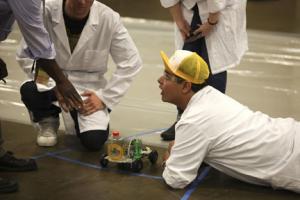
Nothing inspires more sheer AIChE member enthusiasm than the annual undergraduate Chem-E-Car Competition®. For the uninitiated, the Car Competition was inaugurated in 1998 to gain public recognition for chemical engineering, and to create a friendly educational and competitive rivalry between AIChE student chapters. Teams of ChE undergrads build and "race" shoe-box size vehicles, powered by chemical reactions, and calibrated on-the-fly to carry a variable load over a variable distance, stopping on a target mark. Today, 100 ChE schools are active in Chem-E-Car, competing at nine spring regional competitions, with the best performers earning a coveted berth at the finals -- held at the Annual Meeting and National Student Conference in November. This PR-style clip devoted to the November 2009 National Competition in Nashville, sums up the action, includes comments from the leader of the winning team from Northeastern Univ. And below you can see this year's SW regional competition winner from University of Houston, who will be participating in this year's final competition in Salt Lake City in November.
Safety is Now an Important Requirement
What publicity like this often fails to mention is the increasingly rigorous safety compliance and training activities that are now integral to Chem-E-Car. In fact, the Car Competition doesn't exist without its safety program -- both as a practical matter as well as a mandate. Four years ago, AIChE's Board of Directors temporarily suspended the competition due to reports of careless safety practices and inconsistent supervision. A group of AIChE member volunteers was tasked to develop what became a multi-faceted safety program that now incorporates annual safety workshops, a safety documentation preparation and review process, and a network of some 100 trained volunteers who conduct onsite vehicle inspections and supervise competitions. AIChE's technical society Safety and Chemical Engineering Education (SACHE) has been at the forefront of the evolving safety training and safe practices efforts, as well as rewritten rules that stress safe vehicle design. A YouTube search turns up dozens of student-made Chem-E-Car videos from years past. Some document the less-cautious approach that existed before the safety program became the focus of the Competition. It wasn't that long ago that the concussion of a pressure explosion -- typically a PET pop bottle -- echoing across a hotel ballroom or convention hall, would elicit celebratory whoops and high-fives from students. The AIChE and SACHE safety program -- led over the past four years by members Dan Crowl, Ron Willey and Tara Henriksen -- has been vigorously fighting that cultural inclination. The message to students is that not only will AIChE permit no careless safety practices, but that potential employers will tolerate no such lack of care and discipline. Safety was definitely a part of the 2010 SW regional competition as you can see in this excerpt from Cullen College of Engineering in Houston:
At the Beaumont conference, paid for, in part, by BP America and Chevron, seven schools were registered to compete. UH and three others were the only ones to make it beyond the first portion of the two-part competition--the poster presentation and safety inspection. These cars, deemed safe by judges, went on to demonstrate their car's ability to travel 50 feet carrying a water payload of 500 milliliters. Further challenging them to make precise calculations under stringent deadlines--these specifications were given to competitors only one hour prior to the exercise.
And now you can take a look at the Cougalac--a 26lb car named after a gas gulping relative of a similar name--and winner of the SW regional AIChE Chem-E-Car Competition:



Comments
As a safety judge for the SW Regional, I have to say that I was impressed with attention to safety both students and professors have exhibited in designing and building these cars. A lot of props goes to SACHE for working very hard to make this competition safe for all those involved. I encourage any engineer in industry to participate and help us to continue to show students the importance of safety in our work.
I agree that safety is something that should be taught at the undergraduate level, but I think that in some cases that is not accomplished very well for several reasons. It is difficult as a student to take safety seriously when crucial hazards are not encountered on a regular basis - "don't spill anything and create a slip hazard" and "don't put liquids near electrical equipment" are sometimes about the best you can come up with when most of your experience has been with a generic ChemE lab. Also, the broad safety guidelines taught in class are sometimes very difficult to apply to chem-e cars because a chem-e car is not an industrial process. Lastly, professor involvement in the safety analysis is critical, because the attitudes of the students will reflect the attitudes of the professors towards safety, either good or bad. Those are just my thoughts, and I hope that students continue to be challenged to pay attention to safety in the AIChE competition.